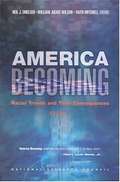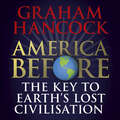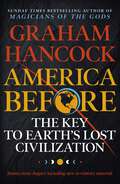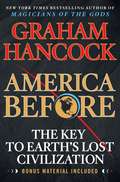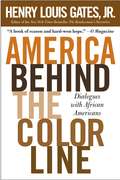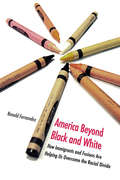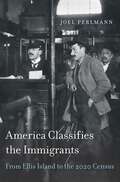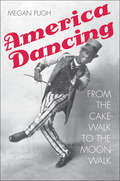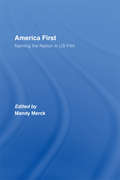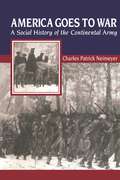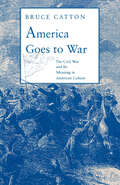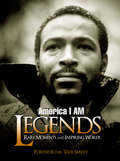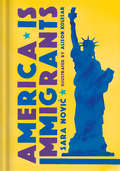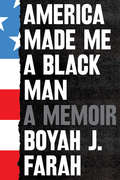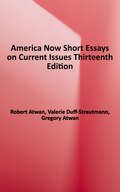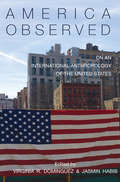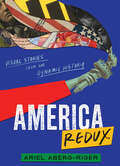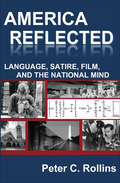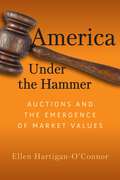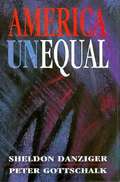- Table View
- List View
America Becoming: Racial Trends and Their Consequences
by National Research CouncilThe 20th Century has been marked by enormous change in terms of how we define race. In large part, we have thrown out the antiquated notions of the 1800s, giving way to a more realistic, sociocultural view of the world. The United States is, perhaps more than any other industrialized country, distinguished by the size and diversity of its racial and ethnic minority populations. Current trends promise that these features will endure. Fifty years from now, there will most likely be no single majority group in the United States. How will we fare as a nation when race-based issues such as immigration, job opportunities, and affirmative action are already so contentious today?In America Becoming, leading scholars and commentators explore past and current trends among African Americans, Hispanics, Asian Americans, and Native Americans in the context of a white majority. This volume presents the most up-to-date findings and analysis on racial and social dynamics, with recommendations for ongoing research. It examines compelling issues in the field of race relations, including: Race and ethnicity in criminal justice. Demographic and social trends for Hispanics, Asian Americans, and Native Americans. Trends in minority-owned businesses. Wealth, welfare, and racial stratification. Residential segregation and the meaning of "neighborhood." Disparities in educational test scores among races and ethnicities. Health and development for minority children, adolescents, and adults. Race and ethnicity in the labor market, including the role of minorities in America's military. Immigration and the dynamics of race and ethnicity. The changing meaning of race. Changing racial attitudes.This collection of papers, compiled and edited by distinguished leaders in the behavioral and social sciences, represents the most current literature in the field. Volume 1 covers demographic trends, immigration, racial attitudes, and the geography of opportunity. Volume 2 deals with the criminal justice system, the labor market, welfare, and health trends, Both books will be of great interest to educators, scholars, researchers, students, social scientists, and policymakers.
America Before: A new investigation into the mysteries of the human past by the bestselling author of Fingerprints of the Gods and Magicians of the Gods
by Graham Hancock***THE SUNDAY TIMES TOP TEN BESTSELLER***'Hancock's books provide a fascinating, alternative version of prehistory. America Before, detailed and wide-ranging, turns what was myth and legend into a new story of the past.' Daily MailWas an advanced civilization lost to history in the global cataclysm that ended the last Ice Age? Graham Hancock, the internationally bestselling author, has made it his life's work to find out -- and in America Before, he draws on the latest archaeological and DNA evidence to bring his quest to a stunning conclusion.We've been taught that North and South America were empty of humans until around 13,000 years ago - amongst the last great landmasses on earth to have been settled by our ancestors. But new discoveries have radically reshaped this long-established picture and we know now that the Americas were first peopled more than 130,000 years ago - many tens of thousands of years before human settlements became established elsewhere.Hancock's research takes us on a series of journeys and encounters with the scientists responsible for the recent extraordinary breakthroughs. In the process, from the Mississippi Valley to the Amazon rainforest, he reveals that ancient 'New World' cultures share a legacy of advanced scientific knowledge and sophisticated spiritual beliefs with supposedly unconnected 'Old World' cultures. Have archaeologists focussed for too long only on the 'Old World' in their search for the origins of civilization while failing to consider the revolutionary possibility that those origins might in fact be found in the 'New World'?America Before: The Key to Earth's Lost Civilisation is the culmination of everything that millions of people have loved in Hancock's body of work over the past decades, namely a mind-dilating exploration of the mysteries of the past, amazing archaeological discoveries and profound implications for how we lead our lives today.(P)2019 Hodder & Stoughton Limited
America Before: A new investigation into the mysteries of the human past by the bestselling author of Fingerprints of the Gods and Magicians of the Gods
by Graham Hancock***THE SUNDAY TIMES TOP TEN BESTSELLER***'Hancock's books provide a fascinating, alternative version of prehistory. America Before, detailed and wide-ranging, turns what was myth and legend into a new story of the past.' Daily MailWas an advanced civilization lost to history in the global cataclysm that ended the last Ice Age? Graham Hancock, the internationally bestselling author, has made it his life's work to find out -- and in America Before, he draws on the latest archaeological and DNA evidence to bring his quest to a stunning conclusion.We've been taught that North and South America were empty of humans until around 13,000 years ago - amongst the last great landmasses on earth to have been settled by our ancestors. But new discoveries have radically reshaped this long-established picture and we know now that the Americas were first peopled more than 130,000 years ago - many tens of thousands of years before human settlements became established elsewhere.Hancock's research takes us on a series of journeys and encounters with the scientists responsible for the recent extraordinary breakthroughs. In the process, from the Mississippi Valley to the Amazon rainforest, he reveals that ancient 'New World' cultures share a legacy of advanced scientific knowledge and sophisticated spiritual beliefs with supposedly unconnected 'Old World' cultures. Have archaeologists focussed for too long only on the 'Old World' in their search for the origins of civilization while failing to consider the revolutionary possibility that those origins might in fact be found in the 'New World'?America Before: The Key to Earth's Lost Civilisation is the culmination of everything that millions of readers have loved in Hancock's body of work over the past decades, namely a mind-dilating exploration of the mysteries of the past, amazing archaeological discoveries and profound implications for how we lead our lives today.
America Before: A new investigation into the mysteries of the human past by the bestselling author of Fingerprints of the Gods and Magicians of the Gods
by Graham Hancock***THE SUNDAY TIMES TOP TEN BESTSELLER***'Hancock's books provide a fascinating, alternative version of prehistory. America Before, detailed and wide-ranging, turns what was myth and legend into a new story of the past.' Daily MailWas an advanced civilization lost to history in the global cataclysm that ended the last Ice Age? Graham Hancock, the internationally bestselling author, has made it his life's work to find out -- and in America Before, he draws on the latest archaeological and DNA evidence to bring his quest to a stunning conclusion.We've been taught that North and South America were empty of humans until around 13,000 years ago - amongst the last great landmasses on earth to have been settled by our ancestors. But new discoveries have radically reshaped this long-established picture and we know now that the Americas were first peopled more than 130,000 years ago - many tens of thousands of years before human settlements became established elsewhere.Hancock's research takes us on a series of journeys and encounters with the scientists responsible for the recent extraordinary breakthroughs. In the process, from the Mississippi Valley to the Amazon rainforest, he reveals that ancient 'New World' cultures share a legacy of advanced scientific knowledge and sophisticated spiritual beliefs with supposedly unconnected 'Old World' cultures. Have archaeologists focussed for too long only on the 'Old World' in their search for the origins of civilization while failing to consider the revolutionary possibility that those origins might in fact be found in the 'New World'?America Before: The Key to Earth's Lost Civilisation is the culmination of everything that millions of readers have loved in Hancock's body of work over the past decades, namely a mind-dilating exploration of the mysteries of the past, amazing archaeological discoveries and profound implications for how we lead our lives today.
America Before: The Key to Earth's Lost Civilization
by Graham HancockWas an advanced civilization lost to history in the global cataclysm that ended the last Ice Age? Graham Hancock, the internationally bestselling author, has made it his life's work to find out--and in America Before, he draws on the latest archaeological and DNA evidence to bring his quest to a stunning conclusion. <P><P>We’ve been taught that North and South America were empty of humans until around 13,000 years ago – amongst the last great landmasses on earth to have been settled by our ancestors. But new discoveries have radically reshaped this long-established picture and we know now that the Americas were first peopled more than 130,000 years ago – many tens of thousands of years before human settlements became established elsewhere. <P><P>Hancock's research takes us on a series of journeys and encounters with the scientists responsible for the recent extraordinary breakthroughs. In the process, from the Mississippi Valley to the Amazon rainforest, he reveals that ancient "New World" cultures share a legacy of advanced scientific knowledge and sophisticated spiritual beliefs with supposedly unconnected "Old World" cultures. Have archaeologists focused for too long only on the "Old World" in their search for the origins of civilization while failing to consider the revolutionary possibility that those origins might in fact be found in the "New World"? <P><P>America Before: The Key to Earth's Lost Civilization is the culmination of everything that millions of readers have loved in Hancock's body of work over the past decades, namely a mind-dilating exploration of the mysteries of the past, amazing archaeological discoveries and profound implications for how we lead our lives today. <P><b>A New York Times Bestseller</b>
America Behind the Color Line: Dialogues with African Americans
by Henry Louis Gates Jr.Gates, the eminent Harvard scholar and author, traveled around the US to find out why and how black America has split into what he sees as two distinct communities: one privileged and one disenfranchised. The book, the companion to a PBS television series of the same name, comprises about 40 essays focusing on individuals (both prominent and obscure) who inhabit four spheres: the "ebony towers" of academia, government, and business; the American South, whose black population increased by almost 3.6 million in the 1990s; black Hollywood; and Chicago's South Side, where a parallel world of extreme black poverty persists. Gates' interviewees talk about race, class, and what it means to be African-American in the 21st century. Annotation ©2004 Book News, Inc., Portland, OR (booknews.com)
America Beyond Black and White: How Immigrants and Fusions Are Helping Us Overcome the Racial Divide
by Ronald Fernandez"This book is both powerful and important. Powerful for the testimony it provides from Americans of many different (and even mixed races) about their experiences. And important because there is a racial revolution underway that will upend race as we know it during the twenty-first century. ” -John Kenneth White, Catholic University of America America Beyond Black and Whiteis a call for a new way of imagining race in America. For the first time in U. S. history, the black-white dichotomy that has historically defined race and ethnicity is being challenged, not by a small minority, but by the fastest-growing and arguably most vocal segment of the increasingly diverse American population-Mexicans, Chinese, Japanese, Koreans, Indians, Arabs, and many more-who are breaking down and recreating the very definitions of race. Drawing on interviews with hundreds of Americans who don’t fit conventional black/white categories, the author invites us to empathize with these "doubles” and to understand why they may represent our best chance to throw off the strictures of the black/white dichotomy. The revolution is already underway, as newcomers and mixed-race "fusions” refuse to engage in the prevailing Anglo- Protestant culture. Americans face two choices: understand why these individuals think as they do, or face a future that continues to define us by what divides us rather than by what unites us.
America Border Culture Dreamer: The Young Immigrant Experience from A to Z
by Wendy EwaldFirst- and second-generation immigrants to the US from all around the world collaborate with renowned photographer Wendy Ewald to create a stunning, surprising catalog of their experiences from A to Z. In a unique collaboration with photographer and educator Wendy Ewald, eighteen immigrant teenagers create an alphabet defining their experiences in pictures and words. Wendy helped the teenagers pose for and design the photographs, interviewing them along the way about their own journeys and perspectives.America Border Culture Dreamer presents Wendy and the students' poignant and powerful images and definitions along with their personal stories of change, hardship, and hope. Created in a collaboration with Al-Bustan Seeds of Culture, this book casts a new light on the crucial, under-heard voices of teenage immigrants themselves, making a vital contribution to the timely national conversation about immigration in America.
America Classifies the Immigrants: From Ellis Island to the 2020 Census
by Joel PerlmannWhen more than twenty million immigrants arrived in the United States between 1880 and 1920, the government attempted to classify them according to prevailing ideas about race and nationality. But this proved hard to do. Ideas about racial or national difference were slippery, contested, and yet consequential—were “Hebrews” a “race,” a “religion,” or a “people”? As Joel Perlmann shows, a self-appointed pair of officials created the government’s 1897 List of Races and Peoples, which shaped exclusionary immigration laws, the wording of the U.S. Census, and federal studies that informed social policy. Its categories served to maintain old divisions and establish new ones. <P><P> Across the five decades ending in the 1920s, American immigration policy built increasingly upon the belief that some groups of immigrants were desirable, others not. Perlmann traces how the debates over this policy institutionalized race distinctions—between whites and nonwhites, but also among whites—in immigration laws that lasted four decades. <P><P> Despite a gradual shift among social scientists from “race” to “ethnic group” after the 1920s, the diffusion of this key concept among government officials and the public remained limited until the end of the 1960s. Taking up dramatic changes to racial and ethnic classification since then, America Classifies the Immigrants concentrates on three crucial reforms to the American Census: the introduction of Hispanic origin and ancestry (1980), the recognition of mixed racial origins (2000), and a rethinking of the connections between race and ethnic group (proposed for 2020).
America Dancing
by Megan PughThe history of American dance reflects the nation's tangled culture. Dancers from wildly different backgrounds learned, imitated, and stole from one another. Audiences everywhere embraced the result as deeply American. Using the stories of tapper Bill "Bojangles" Robinson, Ginger Rogers and Fred Astaire, ballet and Broadway choreographer Agnes de Mille, choreographer Paul Taylor, and Michael Jackson, Megan Pugh shows how freedom--that nebulous, contested American ideal--emerges as a genre-defining aesthetic. In Pugh's account, ballerinas mingle with slumming thrill-seekers, and hoedowns show up on elite opera house stages. Steps invented by slaves on antebellum plantations captivate the British royalty and the Parisian avant-garde. Dances were better boundary crossers than their dancers, however, and the issues of race and class that haunt everyday life shadow American dance as well. Deftly narrated, America Dancing demonstrates the centrality of dance in American art, life, and identity, taking us to watershed moments when the nation worked out a sense of itself through public movement.
America First: Naming the Nation in US Film
by Mandy MerckAt a time when the expanded projection of US political, military, economic and cultural power draws intensified global concern, understanding how that country understands itself seems more important than ever. This collection of new critical essays tackles this old problem in a new way, by examining some of the hundreds of US films that announce themselves as titularly 'American'. From early travelogues to contemporary comedies, national nomination has been an abiding characteristic of American motion pictures, heading the work of Porter, Guy-Blaché, DeMille, Capra, Sternberg, Vidor, Minnelli and Mankiewicz. More recently, George Lucas, Paul Schrader, John Landis and Edward James Olmos have made their own contributions to Hollywood’s Americana. What does this national branding signify? Which versions of Americanism are valorized, and which marginalized or excluded? Out of which social and historical contexts do they emerge, and for and by whom are they constructed? Edited by Mandy Merck, the collection contains detailed analyses of such films as The Vanishing American, American Madness, An American in Paris, American Graffiti, American Gigolo, American Pie and many more.
America Goes to War: A Social History of the Continental Army (The American Social Experience #26)
by Charles Patrick NeimeyerA unique and revealing analysis of the diverse body that made up the Continental Army during the American Revolutionary War.One of the images Americans hold most dear is that of the drum-beating, fire-eating Yankee Doodle Dandy rebel, overpowering his British adversaries through sheer grit and determination. The myth of the classless, independence-minded farmer or hard-working artisan-turned-soldier is deeply ingrained in the national psyche.Charles Neimeyer here separates fact from fiction, revealing for the first time who really served in the army during the Revolution and why. His conclusions are startling. Because the army relied primarily on those not connected to the new American aristocracy, the African Americans, Irish, Germans, Native Americans, laborers-for-hire, and “free white men on the move” who served in the army were only rarely altruistic patriots driven by a vision of liberty and national unity.Bringing to light the true composition of the enlisted ranks, the relationships of African-Americans and of Native Americans to the army, and numerous acts of mutiny, desertion, and resistance against officers and government, Charles Patrick Neimeyer here provides the first comprehensive and historically accurate portrait of the Continental soldier.
America Goes to War: The Civil War and Its Meaning in American Culture
by Bruce CattonA fascinating study of the first modern war and its effect on American Culture.
America I am legends: Rare Moments And Inspiring Words
by Tavis SmileyWould America have been America without her Negro people?" - W. E. B. Du Bois America I AM: The African American Imprint, a national traveling museum exhibition, was conceived by award-winning broadcaster and bestselling author Tavis Smiley as a one-of-a-kind multi-media experience that chronicles the distinct history of African Americans. This beautifully conceived companion volume addresses the central theme of the exhibition, posed by W. E. B. Du Bois: "Would America have been America without her Negro people?" Through exceptional photographic images and penetrating words, America I AM Legends captures the dynamism of 78 legendary African Americans, highlighting the indelible imprint each has made on the United States and the world. A statement illuminating a unique aspect of each iconic figure- made by the legend or by someone carrying on their legacy today-portrays the vision and contribution of each subject. Whether black artistic genius, athletic excellence, political leadership, or the struggle to hold America true to its promise, each legend reminds us that America would be unrecognizable without its African American imprint. America I AM Legends takes us on an unforgettable journey to the heart of the American experience.
America Is Immigrants
by Sara NovicA gorgeously illustrated collection featuring inspiring immigrants from every country in the world, celebrating the incredible range of what it means to be an American This dazzling volume brings American immigrant stories to life in short biographies written by award-winning writer Sara Nović, with charming full-color illustrations by Alison Kolesar. At a time when public debate is focused on who belongs in America, this book honors the crucial contributions of our friends and neighbors who have chosen to make this country their home. Featured within are war heroes and fashion designers, Supreme Court justices and pop stars, athletes and civil rights leaders, as well as: • the doctors who saved Ronald Reagan’s life • the creators of iconic American products like Levi’s, Chevy cars and trucks, and Nathan’s Famous hot dogs • the scientists who contributed to the Manhattan Project • the architects behind landmarks of the American skyline like the World Financial Center in New York City, the Gateway Arch in St. Louis, and the Sears Tower in Chicago • Plus these familiar names from every walk of life: Madeleine Albright • Isabel Allende • Mario Andretti • Desi Arnaz • Isaac Asimov • George Balanchine • Sergey Brin • Gisele Bündchen • Willem de Kooning • Oscar de la Renta • Marlene Dietrich • Albert Einstein • Alfred Hitchcock • Arianna Huffington • Enrique Iglesias • Iman • Grace Jones • Henry Kissinger • Mila Kunis • Hedy Lamarr • Yo-Yo Ma • Miriam Makeba • Pedro Martínez • Joni Mitchell • Sidney Poitier • Wolfgang Puck • Rihanna • Knute Rockne • M. Night Shyamalan • Gene Simmons • Nikola Tesla • the von Trapps • Elie Wiesel • Anna Wintour
America Is the Prison: Arts and Politics in Prison in the 1970s
by Lee BernsteinIn the 1970s, while politicians and activists outside prisons debated the proper response to crime, incarcerated people helped shape those debates though a broad range of remarkable political and literary writings. Lee Bernstein explores the forces that sparked a dramatic "prison art renaissance," shedding light on how incarcerated people produced powerful works of writing, performance, and visual art. These included everything from George Jackson's revolutionary Soledad Brother to Miguel Pinero's acclaimed off-Broadway play and Hollywood film Short Eyes. An extraordinary range of prison programs--fine arts, theater, secondary education, and prisoner-run programs--allowed the voices of prisoners to influence the Black Arts Movement, the Nuyorican writers, "New Journalism," and political theater, among the most important aesthetic contributions of the decade. By the 1980s and '90s, prisoners' educational and artistic programs were scaled back or eliminated as the "war on crime" escalated. But by then these prisoners' words had crossed over the wall, helping many Americans to rethink the meaning of the walls themselves and, ultimately, the meaning of the society that produced them.
America Made Me a Black Man: A Memoir
by Boyah J. FarahA searing memoir of American racism from a Somalian-American who survived hardships in his birth country only to experience firsthand the dehumanization of Blacks in his adopted land, the United States.“No one told me about America.” Born in Somalia and raised in a valley among nomads, Boyah Farah grew up with a code of male bravado that helped him survive deprivation, disease, and civil war. Arriving in America, he believed that the code that had saved him would help him succeed in this new country. But instead of safety and freedom, Boyah found systemic racism, police brutality, and intense prejudice in all areas of life, including the workplace. He learned firsthand not only what it meant to be an African in America, but what it means to be African American. The code of masculinity that shaped generations of men in his family could not prepare Farah for the painful realities of life in the United States. Lyrical yet unsparing, America Made Me a Black Man is the first book-length examination of American racism from an African outsider’s perspective. With a singular poetic voice brimming with imagery, Boyah challenges us to face difficult truths about the destructive forces that threaten Black lives and attempts to heal a fracture in Black men’s identity.
America Now: Short Essays on Current Issues, Thirteenth Edition
by Robert AtwanAmerica Now makes it easy for you to bring brief, thought-provoking essays on contemporary topics into your classroom, with reliable pedagogy and an expert reader's knowledge of what works for students. As series editor for The Best American Essays, Robert Atwan constantly scours a wide range of publications, bringing to America Now an unrivaled focus on today’s best writing. Instructors tell us that their students want to respond to the essays in the book, and they praise the high-quality reading and writing instruction, critical thinking and reading questions, and model student essays that help them do so. Over half of the readings in America Now are new to this edition and published since 2018, making it truly a book for today's composition course.
America Observed: On an International Anthropology of the United States
by Virginia R. Dominguez Jasmin HabibThere is surprisingly little fieldwork done on the United States by anthropologists from abroad. America Observed fills that gap by bringing into greater focus empirical as well as theoretical implications of this phenomenon. Edited by Virginia Dominguez and Jasmin Habib, the essays collected here offer a critique of such an absence, exploring its likely reasons while also illustrating the advantages of studying fieldwork-based anthropological projects conducted by colleagues from outside the U.S. This volume contains an introduction written by the editors and fieldwork-based essays written by Helena Wulff, Jasmin Habib, Limor Darash, Ulf Hannerz, and Moshe Shokeid, and reflections on the broad issue written by Geoffrey White, Keiko Ikeda, and Jane Desmond. Suitable for introductory and mid-level anthropology courses, America Observed will also be useful for American Studies courses both in the U.S. and elsewhere.
America Redux: Visual Stories from Our Dynamic History
by Ariel Aberg-RigerA critical, unflinching cultural history and fierce beacon of hope for a better future, America Redux is a necessary and galvanizing read. What are the stories we tell ourselves about America? How do they shape our sense of history, cloud our perceptions, inspire us? America Redux explores the themes that create our shared sense of American identity and interrogates the myths we’ve been telling ourselves for centuries. With iconic American catchphrases as chapter titles, these twenty-one visual stories illuminate the astonishing, unexpected, sometimes darker sides of history that reverberate in our society to this very day—from the role of celebrity in immigration policy to the influence of one small group of white women on education to the effects of “progress” on housing and the environment, to the inspiring force of collective action and mutual aid across decades and among diverse groups. Fully illustrated with collaged archival photographs, maps, documents, graphic elements, and handwritten text, this book is a dazzling, immersive experience that jumps around in time and will make you view history in a whole different light.
America Reflected: Language, Satire, Film, and the National Mind
by Peter C. RollinsEclectic criticism and insightful observations from “one of the most respected cultural historians working today” (Ronald A. Wells, Professor of History Emeritus, Calvin College). “From cowboy philosopher Will Rogers to popular perceptions of two world wars and Vietnam, from the history of language to the language of film and television, Peter Rollins has devoted his career to exploring the intriguing ways in which the creative impulse both shapes and reflects American culture. His observations are fresh, illuminating and of enduring value.” —John E. O’Connor, co-founder/editor of Film & History: An Interdisciplinary Journal of Film and Television Studies“Examines the roles of language, satire, and film in reflecting the American consciousness through such diverse sources as Orestes Brownson, Benjamin Lee Whorf, Will Rogers, and Hollywood. Readers of America Reflected are in for a delightful voyage as they travel through American history and culture with Peter Rollins as their guide providing personal and scholarly insights into the shaping of the American mind.” —Ron Briley, editor of The Politics of Baseball: Essays on the Pastime and Power at Home and Abroad“Even those who have known and admired Peter Rollins’s acclaimed works will here find enlightening surprises. Epistemology, language theory, war’s polemics, filmed history, and an array of significant creators of American culture are all elegantly displayed. This book will make you a wiser person and charm you while it does it.” —John Shelton Lawrence, Emeritus Professor of Philosophy, Morningside College“Two decades ago I was privileged to work on a book, America Observed, with Alistair Cooke. Now we have America Reflected by Peter Rollins . . . Not only does Rollins make good observations about our lives and times, his reflections on a diverse set of subjects helps us to see the meanings of our observations.” —Ronald A. Wells, Professor of History Emeritus, Calvin College “Rollins gathers together glimpses of our shared worlds, so that we may observe their interconnections across media, genres, and time. From down-home values and front-porch philosophy, to tales of wars and chronicles of lives, the subjects considered here are all part of the stories we tell about ourselves and our social worlds.” —Cynthia J. Miller, President, Literature/Film Association
America The Unusual
by John W. KingdonKingdon explores how the American polity is different from that of other countries - particularly other Western democracies - examining just how this uniqueness came about. It invites both introductory and advanced students to appreciate the roots and limits of American exceptionalism, and to recognize the profound importance of current debates over the government's role in our everyday lives.
America Under the Hammer: Auctions and the Emergence of Market Values (Early American Studies)
by Ellen Hartigan-O'ConnorReveals how, through auctions, early Americans learned capitalismAs the first book-length study of auctions in early America, America Under the Hammer follows this ubiquitous but largely overlooked institution to reveal how, across the eighteenth and early nineteenth centuries, price became an accepted expression of value. From the earliest days of colonial conquest, auctions put Native land and human beings up for bidding alongside material goods, normalizing new economic practices that turned social relations into economic calculations and eventually became recognizable as nineteenth-century American capitalism.Starting in the eighteenth century, neighbors collectively turned speculative value into economic “facts” in the form of concrete prices for specific items, thereby establishing ideas about fair exchange in their communities. This consensus soon fractured: during the Revolutionary War, state governments auctioned loyalist property, weaponizing local group participation in pricing and distribution to punish political enemies. By the early nineteenth century, suspicion that auction outcomes were determined by manipulative auctioneers prompted politicians and satirists to police the boundaries of what counted as economic exchange and for whose benefit the economy operated. Women at auctions—as commodities, bidders, or beneficiaries—became a focal point for gendering economic value itself. By the 1830s, as abolitionists attacked the public sale of enslaved men, women, and children, auctions had enshrined a set of economic ideas—that any entity could be coded as property and priced through competition—that have become commonsense understandings all too seldom challenged.In contrast to histories focused on banks, currencies, or plantations, America Under the Hammer highlights an institution that integrated market, community, and household in ways that put gender, race, and social bonds at the center of ideas about economic worth. Women and men, enslaved and free, are active participants in this story rather than bystanders, and their labor, judgments, and bodies define the resulting contours of the American economy.
America Unequal
by Sheldon Danziger; Peter GottschalkAmerica Unequal challenges the view, emphasized in the Republicans' "Contract with America," that restraining government social spending and cutting welfare should be our top domestic priorities. Instead, it proposes a set of policies that would reduce poverty by supplementing the earnings of low-wage workers and increasing the employment prospects of the jobless. Such demand-side policies, are essential for correcting a labor market that has been increasingly unable to absorb less-skilled and less-experienced workers.
America Works: Thoughts on an Exceptional U.S. Labor Market
by Richard B. FreemanThe U.S. labor market is the most laissez faire of any developed nation, with a weak social safety net and little government regulation compared to Europe or Japan. Some economists point to this hands-off approach as the source of America’s low unemployment and high per-capita income. But the stagnant living standards and rising economic insecurity many Americans now face take some of the luster off the U.S. model. In America Works, noted economist Richard Freeman reveals how U.S. policies have created a labor market remarkable both for its dynamism and its disparities. America Works takes readers on a grand tour of America’s exceptional labor market, comparing the economic institutions and performance of the United States to the economies of Europe and other wealthy countries. The U.S. economy has an impressive track record when it comes to job creation and productivity growth, but it isn’t so good at reducing poverty or raising the wages of the average worker. Despite huge gains in productivity, most Americans are hardly better off than they were a generation ago. The median wage is actually lower now than in the early 1970s, and the poverty rate in 2005 was higher than in 1969. So why have the benefits of productivity growth been distributed so unevenly? One reason is that unions have been steadily declining in membership. In Europe, labor laws extend collective bargaining settlements to non-unionized firms. Because wage agreements in America only apply to firms where workers are unionized, American managers have discouraged unionization drives more aggressively. In addition, globalization and immigration have placed growing competitive pressure on American workers. And boards of directors appointed by CEOs have raised executive pay to astronomical levels. Freeman addresses these problems with a variety of proposals designed to maintain the vigor of the U.S. economy while spreading more of its benefits to working Americans. To maintain America’s global competitive edge, Freeman calls for increased R&D spending and financial incentives for students pursuing graduate studies in science and engineering. To improve corporate governance, he advocates licensing individuals who serve on corporate boards. Freeman also makes the case for fostering worker associations outside of the confines of traditional unions and for establishing a federal agency to promote profit-sharing and employee ownership. Assessing the performance of the U.S. job market in light of other developed countries’ recent history highlights the strengths and weaknesses of the free market model. Written with authoritative knowledge and incisive wit, America Works provides a compelling plan for how we can make markets work better for all Americans. A Volume in the Russell Sage Foundation's Centennial Series
